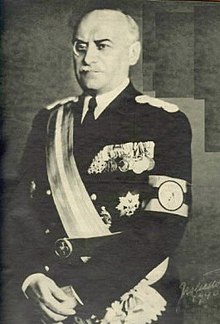Ion Gigurtu
| Ion Gigurtu | |
|---|---|
 |
|
| Prime Minister of Romania | |
|
In office 4 July 1940 – 5 September 1940 |
|
| Monarch | Carol II |
| Preceded by | Gheorghe Tătărescu |
| Succeeded by | Ion Antonescu |
| Personal details | |
| Born | 24 June 1886 Turnu Severin, Mehedinţi County, Kingdom of Romania |
| Died | November 24, 1959 (aged 73) Râmnicu Sărat, Buzău Region, Romanian People's Republic |
| Nationality | Romanian |
| Political party |
People's Party (to 1932) National Agrarian Party (1932-1935) National Christian Party (1935-1938) National Renaissance Front (1938-1940) Party of the Nation (1940) |
| Profession | Officer, industrialist |
| Military service | |
| Allegiance | Kingdom of Romania |
| Service/branch | Romanian Land Forces |
| Battles/wars |
Second Balkan War World War I World War II |
Ion Gigurtu (Romanian pronunciation: [iˈon d͡ʒiˈɡurtu]; June 24, 1886 – November 24, 1959) was a far-right Romanian politician, Land Forces officer, engineer and industrialist who served a brief term as Prime Minister from July 4 to September 4, 1940, under the personal regime of King Carol II. A specialist in mining and veteran of both the Second Balkan War and World War I, he made a fortune in interwar Greater Romania. Gigurtu began his career in politics with the People's Party (PP) and the National Agrarian Party, moving closer to the far right during the 1930s, and serving as Minister of Industry and Commerce in the cabinet of Octavian Goga. Shortly after the start of World War II, Gigurtu was affiliated with King Carol's National Renaissance Front, serving as Public Works and Communications Minister and Foreign Minister under Premier Gheorghe Tătărescu, before the territorial losses incurred by Romania in front of the Soviet Union propelled him as Tătărescu's replacement.
...
Wikipedia
